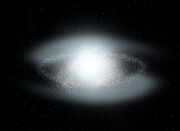


[Physics Today] Type Ia supernovae are not only very bright but remarkably uniform, and thus are useful to cosmologists as standard candles for gauging distances across the universe. It was studies of Type Ia supernovae by Berkeley Lab’s Supernova Cosmology Project and others, in fact, that led to the discovery that the expansion of the universe is accelerating because of dark energy. Now research groups including the Nearby Supernova Factory based at Berkeley Lab have collected detailed data on unusually bright, unusually massive supernovae that could point the way toward a better understanding of Type Ia physics and make them better standard candles. More>
 Ajay Mathur, director general of India’s Bureau of Energy Efficiency and a member of the Pime Minister's Council on Climate Change, will deliver the next Environmental Energy Technologies Division Distinguished Lecture on Thursday, May 13, at 11 a.m. in the Building 66 Auditorium. His talk, titled “Energy Efficiency in India: Challenges and Initiatives,” will cover the challenges and opportunities confronting India as it pursues policies to unlock the full potential of energy efficiency in the country. More>
Ajay Mathur, director general of India’s Bureau of Energy Efficiency and a member of the Pime Minister's Council on Climate Change, will deliver the next Environmental Energy Technologies Division Distinguished Lecture on Thursday, May 13, at 11 a.m. in the Building 66 Auditorium. His talk, titled “Energy Efficiency in India: Challenges and Initiatives,” will cover the challenges and opportunities confronting India as it pursues policies to unlock the full potential of energy efficiency in the country. More>
 Using NERSC systems, William Detmold of DOE's Thomas Jefferson National Accelerator Facility, and his colleagues, achieved the first ever QCD calculations for both a three-body force between hadrons and three-body baryon system. In a subsequent paper, Detmold and Martin Savage also reported another first: a QCD calculation that could help scientists better understand the quark soup that was our universe milliseconds after its birth. More>
Using NERSC systems, William Detmold of DOE's Thomas Jefferson National Accelerator Facility, and his colleagues, achieved the first ever QCD calculations for both a three-body force between hadrons and three-body baryon system. In a subsequent paper, Detmold and Martin Savage also reported another first: a QCD calculation that could help scientists better understand the quark soup that was our universe milliseconds after its birth. More>
 [SF Weekly] According to a San Francisco non-profit, donating your hair can help clean up one of the worst oil spills in United States history. The Huffington Post and plenty of other news media outlets have recently run straight-faced stories on this "innovative solution." Because it seemed slightly absurd, we called our favorite bioremediation expert Terry Hazen, with Berkeley Lab’s Earth Sciences Division. Sure enough, the idea that hair can make a dent in the Deep Water Horizon clean up cracked Hazen up. More>
[SF Weekly] According to a San Francisco non-profit, donating your hair can help clean up one of the worst oil spills in United States history. The Huffington Post and plenty of other news media outlets have recently run straight-faced stories on this "innovative solution." Because it seemed slightly absurd, we called our favorite bioremediation expert Terry Hazen, with Berkeley Lab’s Earth Sciences Division. Sure enough, the idea that hair can make a dent in the Deep Water Horizon clean up cracked Hazen up. More>
 Postdoctoral scholars are the lifeblood of any research institution. Too often, though, they work in relative anonymity before heading off to their own scientific careers across the country and around the world. The "Meet a Postdoc" video series turns some much-needed light on this important segment of Berkeley Lab's population and offers a chance to learn more about them as individuals while they are in our midst. Today’s subject is Adam Wallace with the Earth Sciences Division. Are you a postdoc who’d like to participate in the series, or do you know a postdoc you’d like to see profiled? If so, let us know. Go here to view Wallace's clip and other "Meet a Postdoc" videos.
Postdoctoral scholars are the lifeblood of any research institution. Too often, though, they work in relative anonymity before heading off to their own scientific careers across the country and around the world. The "Meet a Postdoc" video series turns some much-needed light on this important segment of Berkeley Lab's population and offers a chance to learn more about them as individuals while they are in our midst. Today’s subject is Adam Wallace with the Earth Sciences Division. Are you a postdoc who’d like to participate in the series, or do you know a postdoc you’d like to see profiled? If so, let us know. Go here to view Wallace's clip and other "Meet a Postdoc" videos.
The Berkeley Lab Learning Institute (BLI) is offering a Microsoft Excel 2007 Intro (BLI0141) class on Wednesday, May 19. The class, taught by CMC, is $75. Due to limited space, employees are encouraged to sign up soon. Go here for information and to register. E-mail a project ID number for payment.
Today
at Berkeley Lab encourages feedback and story ideas
Deadline for submissions is 10 a.m. the day prior to publication
TABL is produced by Public Affairs' Communications Group